A couple years back I took on the daunting task of building my own house. Being a person not in the construction industry, occasionally some projects were farmed out to the "experts." Unfortunately my chimney expert wasn't so, and now I'm sitting here with a conundrum.
The problem:
-The mason set 7x11 tiles, which is oversized for my Keystone.
-It drafts fine because of the height, but takes an extended period of time to get the chimney hot, and I'm getting a LOT of condensation in the clean out on cold starts. (It's not the wood, I'm on the 3 year plan, fresh split face is ~15-18% MC.) After the chimney is up to temp, the condensation issues go away until the chimney is left to cool completely.
-Because of this condensation, I've found a number of joints where the tile must not be sealed because I've got staining/effluents on a few of the block mortar joints.
The solution:
-The obvious - Stainless liner.
I'm planning on dropping a liner down, but the 7x11 is making that a challenge. It hurts my heart thinking about breaking out tiles installed just 2 years ago. In hindsight, they wouldn't be there, but being an owner builder, you can only be an expert in so many things. . .
Some facts about the chimney
-It is centrally located in the house, almost dead center. Exits the roof at the peak.
-Approx 25' from the thimble to the cap.
-2" clearance 100% verified. This was one I item I DID know, and as I built the framing around this thing I KNOW there is at least 2" clearance from the basement to the peak.
I know it is strongly recommended to insulate, and with some manufactures, required. However I've seen many threads note that the insulation is to make it "Zero clearance" and I don't require that as the 2" clearance is maintained.
Is there a liner out there that doesn't require insulation? I understand the performance won't be "as good" as insulated, but it will be better than the clay, and being an internal chimney, that should help even more.
Regards
John
The problem:
-The mason set 7x11 tiles, which is oversized for my Keystone.
-It drafts fine because of the height, but takes an extended period of time to get the chimney hot, and I'm getting a LOT of condensation in the clean out on cold starts. (It's not the wood, I'm on the 3 year plan, fresh split face is ~15-18% MC.) After the chimney is up to temp, the condensation issues go away until the chimney is left to cool completely.
-Because of this condensation, I've found a number of joints where the tile must not be sealed because I've got staining/effluents on a few of the block mortar joints.
The solution:
-The obvious - Stainless liner.
I'm planning on dropping a liner down, but the 7x11 is making that a challenge. It hurts my heart thinking about breaking out tiles installed just 2 years ago. In hindsight, they wouldn't be there, but being an owner builder, you can only be an expert in so many things. . .
Some facts about the chimney
-It is centrally located in the house, almost dead center. Exits the roof at the peak.
-Approx 25' from the thimble to the cap.
-2" clearance 100% verified. This was one I item I DID know, and as I built the framing around this thing I KNOW there is at least 2" clearance from the basement to the peak.
I know it is strongly recommended to insulate, and with some manufactures, required. However I've seen many threads note that the insulation is to make it "Zero clearance" and I don't require that as the 2" clearance is maintained.
Is there a liner out there that doesn't require insulation? I understand the performance won't be "as good" as insulated, but it will be better than the clay, and being an internal chimney, that should help even more.
Regards
John




